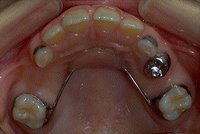If a baby tooth is lost prematurely, a space maintainer will “save” the space.

What are they?
Baby teeth are there for a reason and one reason is to save the space for the permanent tooth.
If a baby tooth has to be removed early due to an abscess or is knocked out in some kind of trauma, a space maintainer may be recommended to save the space for the permanent tooth, which will erupt into its position when the baby tooth is lost normally.
If the space is not preserved, the other teeth may drift causing difficult to treat crowding and orthodontic problems. If it is a front tooth then you don’t need a space maintainer. However, you can place a pediatric partial to replace the teeth for cosmetic reasons.
The “space maintainers” are not permanent and are removed when the new tooth erupts.
Kinds of space maintainers:
1. Fixed Space Maintainers:

a. Unilateral: Just on one side, usually “replacing” one tooth. Can be a band and loop as you see here, or a crown and loop type (in photo below). This can also be a Distal Shoe type. The distal shoe being one used when the permanent first molar has not yet erupted. Hey, you are usually going to get “silver” in there no matter what kind of spacer it is.

Distal Shoe Type for unerupted 1st molar:


b. Bilateral: These are very useful. They are usually cemented with bands on back teeth on both sides connected by a wire just behind the lower incisors. Usually called a Lingual Arch. This can eliminate the need for two unilateral spacers. They are most useful if there is more than one tooth missing or you are trying to keep the lower incisors from tipping. An altered form can incorporate a looped lingual arch to actually move the lower incisors forward (straighten them a little too) before maintaining them in a better position. A maxillary bilateral spacer may incorporate an acrylic button and is called a Nance space maintainer.


2. Removable: I don’t use these too often on children, although sometimes they can be fabricated and used in specific cases. There are like orthodontic retainers, with part of the plastic placed in the empty space to keep things from drifting.


